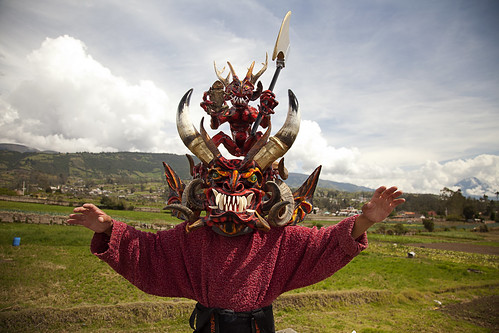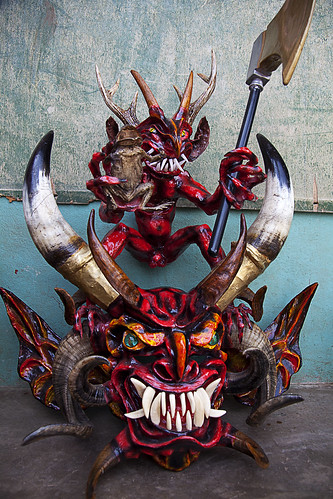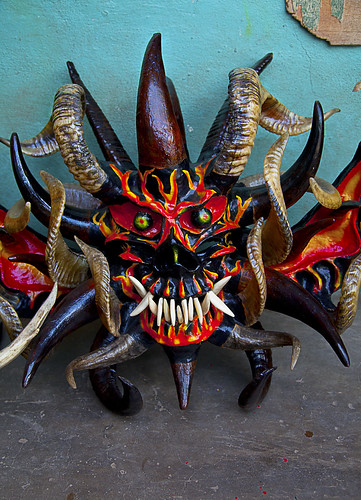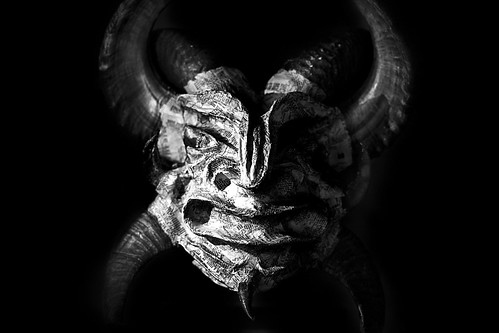Meet Marco Antonio
Callamara. There are two things you should know about him. Firstly,
he's not as scary as he looks. Secondly, he makes devil masks for a
living.
 |
| Marco Antonio Callamara showing off his latest creation |
Marco is from Pillaro
in Ecuador, a chilly town high in the Andes that can only be reached
by a perilous, snaking road from Ambato. Pillaro is most famous for
its diabolical annual festival.
La Diablada Pillarena
is a UNESCO heritage festival with its roots buried deep into black Pagan soil. Sadly, its origins are lost to historians after a riot and fire in the 19th Century destroyed the town's archives. What is clear - the festival has nothing to do with the Catholic church... although there's clearly some fire and brimstone influences bubbling away in the mixed cauldron.
 But the festival isn't
until January - so I'll be back. In the months preceding the annual event the mask
makers of Pillaro are busy adding the finishing touches to their
devilish creations. Like some black metal Blue Peter presenter, I was in Pillaro with the stick back plastic to help make some masks.
But the festival isn't
until January - so I'll be back. In the months preceding the annual event the mask
makers of Pillaro are busy adding the finishing touches to their
devilish creations. Like some black metal Blue Peter presenter, I was in Pillaro with the stick back plastic to help make some masks. Marco specialises in
the wild and wacky. His masks are not traditional, and have a
cheeky sense of humour. Many of his devils have erections or are
cradling bottles of trago.
Marco specialises in
the wild and wacky. His masks are not traditional, and have a
cheeky sense of humour. Many of his devils have erections or are
cradling bottles of trago.
He works from his home
just outside town and in the shade of the Tungurahua volcano. Beneath the washing line his
yard is piled high with half-finished demons and diablos. In his
lifetime he has created 200 masks and they sell for around $300 a
pop.
 |
| Marco's workshop |
We compared one of
Edison's masks with a pre-Incan mask from La Tolita civilisation, now housed in Quito's
Museum and the likeness was extraordinary. Thankfully, there are still some dark
corners the light of Catholic Spain has failed to illuminate.
Edison ran me through
the process of making a devil mask, the entire procedure takes a
couple of weeks but he has several masks on the go.
 |
| Satan in the phone book - look close and you can see numbers |
The masks are fitted
with twisted horns which are secured (presumably with the consent)
from the local ram population. The very finest masks are equipped
with a pair of hairy ears which are secured (presumably without the
consent) from the local pig population. Further accessories include animal teeth or marble eyes.
The masks are made to
order and some people want a real horror show, others want something
cheekier and more loveable. The devil comes in many guises.
Finally the masks are
painted in bright reds and blacks. The outfits are topped with giant
crowns, made from folded cardboard. The headgear is very heavy and
slightly unstable so dancing in one of these costumes under the heat
of the Ecuadorian sun is a real challenge.
 |
| Edison in his workshop |
 |
| Edison working on Satan's snake staff |
 |
| Showing a finished mask |


How i can make contact with this great artist !! ?? Anyone knows how to reach him !? Phone number !? Email or social media !?
ReplyDelete